Graz, Austria
| Graz | ||
|---|---|---|

The Schlossberg (Castle Hill) with the Uhrturm (Clock Tower), the iconic landmark of Graz, from the Townhall
|
||
|
||
| Location within Austria | ||
| Coordinates: 47°4′N 15°26′E / 47.067°N 15.433°ECoordinates: 47°4′N 15°26′E / 47.067°N 15.433°E | ||
| Country | Austria | |
| State | Styria | |
| District | Statutory city | |
| Government | ||
| • Mayor | Siegfried Nagl (ÖVP) | |
| Area | ||
| • Total | 127.56 km2 (49.25 sq mi) | |
| Elevation | 353 m (1,158 ft) | |
| Population (1 January 2016) | ||
| • Total | 280,200 | |
| • Density | 2,200/km2 (5,700/sq mi) | |
| Time zone | CET (UTC+1) | |
| • Summer (DST) | CEST (UTC+2) | |
| Postal codes | A-801x, A-802x, A-803x, A-804x, A-805x | |
| Area codes | +43 316 | |
| Vehicle registration | G | |
| Website | www.graz.at | |
| UNESCO World Heritage Site | |
|---|---|
| Location |
Austria, Allied-occupied Austria, Nazi Germany, Federal State of Austria, First Republic of Austria, Republic of German-Austria, Austria-Hungary, Austrian Empire, Habsburg Empire |
| Criteria | ii, iv |
| Reference | 931bis |
| Coordinates | 47°04′N 15°26′E / 47.07°N 15.43°E |
| Inscription | 1999 (23rd Session) |
| Extensions | 2010 |
| Website | www |
|
[]
|
|
| Largest groups of foreign residents | |
| Nationality | Population (2017) |
|---|---|
|
|
8,093 |
|
|
7,761 |
|
|
7,119 |
|
|
6,790 |
|
|
5,247 |
|
|
4,020 |
|
|
2,849 |
|
|
2,110 |
|
|
2,087 |
|
|
2,061 |
|
|
1,985 |
|
|
1,705 |
|
|
1,641 |
|
|
1,316 |
|
|
1,028 |
|
|
962 |
|
|
924 |
Graz (German pronunciation: [ˈɡʁaːt͡s]; Slovenian: Gradec) is the capital of Styria and second-largest city in Austria after Vienna. On 1 January 2017, it had a population of 320,587 (of which 286,686 had principal residence status). In 2014, the population of the Graz Larger Urban Zone who had principal residence status stood at 605,143.
Graz has a long tradition as a "university town": its six universities have more than 44,000 students. Its "Old Town" is one of the best-preserved city centres in Central Europe.
Politically and culturally, Graz was for centuries more important for Slovenes than Ljubljana, the capital of Slovenia, and still remains influential.
In 1999, Graz was added to the UNESCO list of World Cultural Heritage Sites, and the site was extended in 2010 by Schloss Eggenberg. Graz was sole Cultural Capital of Europe for 2003 and got the title of a City of Culinary Delights in 2008.
The name of the city, Graz, formerly spelled Gratz, stems most likely from the Slavic gradec, "small castle". Some archaeological finds point to the erection of a small castle by Alpine Slavic people, which in time became a heavily defended fortification. In literary Slovene, gradec still means "small castle", forming a hypocoristic derivative of Proto-West-South Slavic *gradьcъ, whichs descends via liquid metathesis from Common Slavic *gardьcъ and via the Slavic third palatalisation from Proto-Slavic *gardiku, originally denoting "small town, settlement". The name thus follows the common South Slavic pattern for naming settlements as grad. The German name 'Graz' first appears in records in 1128.
...
Wikipedia



